About the Neonicotinoid Collaboratory
The primary goal of the Collaboratory is to develop an expandable network of collaborators, and stakeholders, within and outside the CPH that facilitates conducting critical research, education, and future policy development to identify and understand human exposure and health risks from neonicotinoid insecticides.
What are neonicotinoids?
Neonicotinoids are a relatively new class of insecticide, but have become the most widely used class of agricultural insecticides in the world. Historically, neonicotinoid insecticides have been viewed as ideal replacements for more toxic compounds, like organophosphates, due in part to their perceived limited potential to impact the environment and human health. Within the agricultural sector, they are preferred over other pesticides for several reasons, most notably 1) they can be applied using several different methods – as spray, injections or seed treatments, 2) they are thought to have lower toxicity in birds, fish and mammals compared to previously used pesticides, and 3) they have a high selectivity and potency for insects (1-3).
Neonicotinoids are commonly used in the corn belt states like Iowa to protect crops from piercing-sucking pests, like aphids, leafhoppers, and whiteflies (4-7). Neonicotinoids have a variety of formulations and are effective against a wide spectrum of insects at low doses (1). They are used as foliar sprays on soft fruits and in gardens, as bait for cockroaches, as granular formulations to treat pasture and as injections in the timber industry to protect against termites (1, 2). Additionally, they are found in products to control fleas in cats and dogs (3).Neonicotinoid use has become particularly intense in Iowa and neighboring states as a corn and soybean seed treatment.
- H U. Chemistry of Clothianidin and related compounds. Journal of Agricultural and Food Chemistry. 2011;59(7):2932-7.
- Anderson JC DC, Palace VP. Neonicotinoids in the Canadian Aquatic Environment: A Literature Review on Current use of products with a focus on fate, exposure and biological effects. Science of Total Environment. 2015;1(505):409-22.
- Tomizawa M CJ. Neonicotinoid insecticide toxicology: mechanisms of selective action. Annual Review of Pharmacology and Toxicology. 2005;45:247-68.
- Agency EP. Benefits of Neonicotinoid Seed Treatments to Soybean Production. 2014.
- M G. US EPA Concludes Neonicotinoid Seed Treatments of Negligible Benefit to Soybean Production: University of Illinois Extension; 2014
- Simon-Delso N A-RV, Belzunces LP, Bonmatin JM, Chagnon M, Downs C, Furlan L, Gibbons DW, Giorio C, Girolami V, Goulson D, Kreutzweiser DP, Krupke CH, Liess M, Long E, McField M, Mineau P, Mitchell EAD, Morrissey CA, Noome DA, Pisa L, Settele J, Stark JD, Tapparo A, Van Dyck H, Van Praagh J, Van der Sluijs JP, Whitehorn PR, Wiemers M. Systemic insecticides (neonicotinoids and fipronil): trends, uses, mode of action and metabolites. Environmental Science and Pollution Research. 2015;22:5-34.
- Estimated Annual Agricultural Pesticide Use [Internet]. 2016 [cited October 31, 2016]. Available from: https://water.usgs.gov/nawqa/pnsp/usage/maps/index.php.
- B H. Are seed treatments worth the investment? : Southeast Farm Press; 2014 [Available from: http://southeastfarmpress.com/soybeans/are-seed-treatments-worth-investment.
- Stokstad E. Pesticides under fire for risks to pollinators. Science. 2013;340(6133):674-6.
Increased use of neonicotinoids
According to the US. Geological Survey, annual neonicotinoid use in Iowa from 2001 to 2014 has increased by 6,050 times, from 61.9 kg to 374,863 kg.
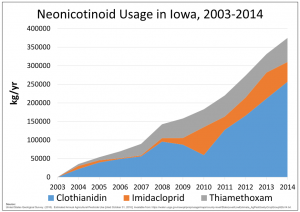
Imidacloprid, clothianidin, and thiamethoxam are the commonly used neonicotinoids. The U.S. Geological Survey’s National Water-Quality Assessment Program (NAWQA) estimates that annual usage of these three chemicals has grown to between 1.4 – 3.5 million pounds (Fig 1, 2, 3) (7).
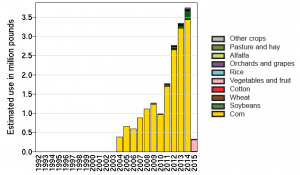
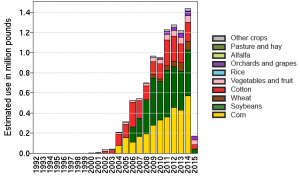
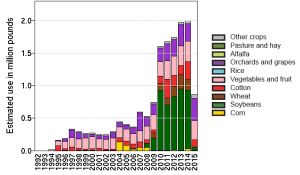
Their use has become particularly prominent (Fig 4-9) in the corn belt states of Iowa, Illinois, Indiana, Michigan, Ohio, Nebraska, Kansas, Minnesota and Missouri (4, 5, 7).
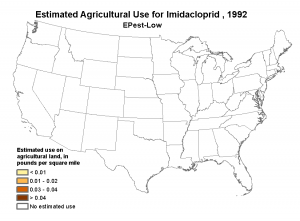
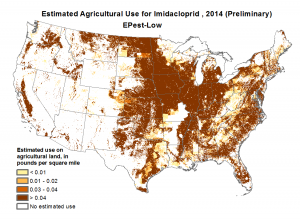
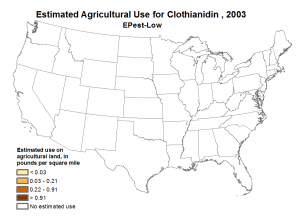
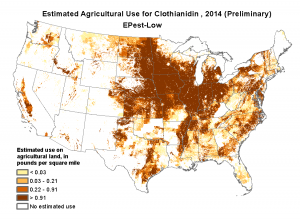
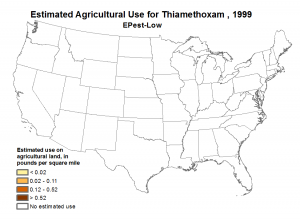
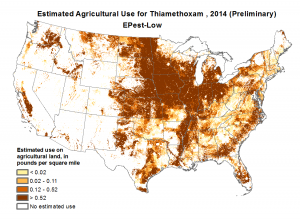
- H U. Chemistry of Clothianidin and related compounds. Journal of Agricultural and Food Chemistry. 2011;59(7):2932-7.
- Anderson JC DC, Palace VP. Neonicotinoids in the Canadian Aquatic Environment: A Literature Review on Current use of products with a focus on fate, exposure and biological effects. Science of Total Environment. 2015;1(505):409-22.
- Tomizawa M CJ. Neonicotinoid insecticide toxicology: mechanisms of selective action. Annual Review of Pharmacology and Toxicology. 2005;45:247-68.
- Agency EP. Benefits of Neonicotinoid Seed Treatments to Soybean Production. 2014.
- M G. US EPA Concludes Neonicotinoid Seed Treatments of Negligible Benefit to Soybean Production: University of Illinois Extension; 2014.
- Simon-Delso N A-RV, Belzunces LP, Bonmatin JM, Chagnon M, Downs C, Furlan L, Gibbons DW, Giorio C, Girolami V, Goulson D, Kreutzweiser DP, Krupke CH, Liess M, Long E, McField M, Mineau P, Mitchell EAD, Morrissey CA, Noome DA, Pisa L, Settele J, Stark JD, Tapparo A, Van Dyck H, Van Praagh J, Van der Sluijs JP, Whitehorn PR, Wiemers M. Systemic insecticides (neonicotinoids and fipronil): trends, uses, mode of action and metabolites. Environmental Science and Pollution Research. 2015;22:5-34.
- Estimated Annual Agricultural Pesticide Use [Internet]. 2016 [cited October 31, 2016]. Available from: https://water.usgs.gov/nawqa/pnsp/usage/maps/index.php.
- B H. Are seed treatments worth the investment? : Southeast Farm Press; 2014 [Available from: http://southeastfarmpress.com/soybeans/are-seed-treatments-worth-investment.
- Stokstad E. Pesticides under fire for risks to pollinators. Science. 2013;340(6133):674-6.
Uses of neonicotinoids
In the US, neonicotinoids are most commonly applied as seed treatments (4-6). Over the past decade there has been a three-fold increase in the use of treated seeds in the US (6-8). Neonicotinoids are commonly used as seed treatments with row crops such as corn, cotton, soybeans, and wheat. In 2013-14 it was estimated that most corn and soybean acreage in the US was treated with neonicotinoid treated seeds (4, 9).
Neonicotinoids have a variety of formulations and are effective against a wide spectrum of insects at low doses (1). They are used as foliar sprays on soft fruits and in gardens, as bait for cockroaches, as granular formulations to treat pasture and as injections in the timber industry to protect against termites (1,2). Additionally, they are found in products to control fleas in cats and dogs (3).
- H U. Chemistry of Clothianidin and related compounds. Journal of Agricultural and Food Chemistry. 2011;59(7):2932-7.
- Anderson JC DC, Palace VP. Neonicotinoids in the Canadian Aquatic Environment: A Literature Review on Current use of products with a focus on fate, exposure and biological effects. Science of Total Environment. 2015;1(505):409-22.
- Tomizawa M CJ. Neonicotinoid insecticide toxicology: mechanisms of selective action. Annual Review of Pharmacology and Toxicology. 2005;45:247-68.
- Agency EP. Benefits of Neonicotinoid Seed Treatments to Soybean Production. 2014.
- M G. US EPA Concludes Neonicotinoid Seed Treatments of Negligible Benefit to Soybean Production: University of Illinois Extension; 2014.
- Simon-Delso N A-RV, Belzunces LP, Bonmatin JM, Chagnon M, Downs C, Furlan L, Gibbons DW, Giorio C, Girolami V, Goulson D, Kreutzweiser DP, Krupke CH, Liess M, Long E, McField M, Mineau P, Mitchell EAD, Morrissey CA, Noome DA, Pisa L, Settele J, Stark JD, Tapparo A, Van Dyck H, Van Praagh J, Van der Sluijs JP, Whitehorn PR, Wiemers M. Systemic insecticides (neonicotinoids and fipronil): trends, uses, mode of action and metabolites. Environmental Science and Pollution Research. 2015;22:5-34.
- Estimated Annual Agricultural Pesticide Use [Internet]. 2016 [cited October 31, 2016]. Available from: https://water.usgs.gov/nawqa/pnsp/usage/maps/index.php.
- B H. Are seed treatments worth the investment? : Southeast Farm Press; 2014 [Available from: http://southeastfarmpress.com/soybeans/are-seed-treatments-worth-investment.
- Stokstad E. Pesticides under fire for risks to pollinators. Science. 2013;340(6133):674-6.